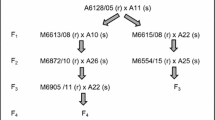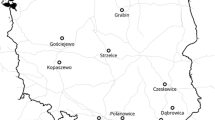Abstract
Norwegian cultivars and breeding materials of perennial ryegrass and Festulolium were planted at three locations in Denmark, France and Japan for testing of resistance against leaf diseases. In general, all plant materials were susceptible to crown rust. The highest incidence of rust attack occurred at the French site, which due to its climatic conditions might be the most suitable testing site for future scoring of similar plant material. Entries based on introgressed genetic materials from UK were most resistant towards crown rust. Crown rust resistance needs increased focus as a breeding objective in the Nordic region due to climate changes, which will most likely lead to increased infection of leaf diseases.
Access provided by CONRICYT-eBooks. Download conference paper PDF
Similar content being viewed by others
Keywords
1 Introduction
The Norwegian plant breeding company Graminor Ltd. develops cultivars of perennial ryegrass (Lolium perenne L.) and ×Festulolium (×Festulolium Aschers. et Graebn.) for Nordic conditions. The main breeding objective in these non-native species has been to improve abiotic stress resistance, especially winter survival to broaden the growing area towards the north and to continental regions. Resistance to biotic stresses like leaf diseases during the growing season has so far had low priority as breeding goals.
Global warming and increased precipitation in the Nordic region will cause favourable conditions for several plant pathogens (IPCC 2013). Fungal diseases like rusts and leaf spots, currently common during summer in warmer climate further south and west in Europe, will spread northwards, and most of our current cultivars will be prone to attack by new diseases. These conditions are so far not predominant in the Nordic region, however, when looking ahead, it will necessitate increased efforts in breeding (Helgadóttir et al. 2016).
Here we present the results from testing susceptibility to crown rust/leaf rust (Puccinia coronata) using a multi-site field experiment with selected cultivars and breeding populations of perennial ryegrass and ×Festulolium at locations with diverse climatic conditions.
2 Material and Methods
A total number of 21 breeding materials and cultivars of perennial ryegrass, hybrid ryegrass (Lolium × boucheanum Kunth), Festulolium and meadow fescue (Festuca pratensis Huds.) were established in field experiments in Denmark (Flakkebjerg, 55°18′N 11°23′ E; 31 m. asl), France (Lusignan, 46°26′N 00°07′E; 134 m. asl), and Japan (Sapporo, 43°03′N 141°20′E, 29 m. asl) in 2012. In 2013, 30 plants in three replicates per entry were scored for percentage of diseased leaf area. Cutting and fertilization were conducted according to standard procedures at each site. Abdelhalim et al. (2016) presented a detailed description of the plant materials concerning parental origin, ploidy level, and region for adaptation. The data was analysed by a multi-factorial analysis using a General Linear Model (SAS 9.4, SAS Institute Inc. Cary. NC. USA) considering entry or parental groups and sites as fixed factors.
3 Results and Discussion
Parental Origin of the Entries.
The five parental groups comprised diploid and tetraploid Festulolium and perennial ryegrass, and meadow fescue. One hybrid ryegrass cultivar was tested and grouped together with tetraploid perennial ryegrasses. When grouped according to parental origin the two groups of Festulolium were significantly less infected than the three remaining groups of perennial ryegrass and meadow fescue when averaged over all sites (F value 26.88; P < 0.0001) (Table 1, Figs. 1 and 2). The two groups of Festulolium were also significantly different, of which diploid Festulolium was less infected than the tetraploid group (34% vs. 44%). Two diploid Festulolium entries were significantly less infected compared with all entries. The least infected population was FuRs0348 (7.7%) originating from a cross between L. multiflorum x F. arundinacea . The population is based on surviving plants from the IBERS population Bx421. Another population with low infection rate was FuRs0353 (15.3%), originating from dihaploid plants made from the Polish cultivar Sulino. This cultivar has a similar genetic background as cv. Felopa (Ghesquière et al. 2010), which in this study was the least infected cultivar of the tetraploid Festulolium group, being significantly different both from the two diploids described above and the remaining entries. Also, population FuRs0356 of the diploid Festulolium group, also originating from IBERS material, revealed low infection rate. This is in contrast to the diploid Festulolium population FuRs0467 which was heavily infected (56.6%), originating from pure Nordic material obviously with no resistance to crown rust.
Observed percentages of crown rust for the investigated entries averaged over sites. Entries 1–5 (FL-d), 6–10 (FL-t), 11–14 (PRG-d), 15–19 (PRG-t), MF (20-21) (see Table 1 for description of parental groups).
Distribution of the five parental groups for crown rust infection averaged over sites (see Table 1 for description of parental groups).
Meadow fescue was included in the test since it has been the most important Festuca parent in the Norwegian breeding program of Festulolium. The two main cultivars, adapted for southern (Fure) and northern (Norild) parts of Norway, were both heavily infected, 51% and 49%, respectively. During the last decade, increasing incidences of leaf diseases have been observed in regrowth of meadow fescue in agricultural leys, although not documented.
Environmental Effects.
Incidence of crown rust was observed at all three sites, however, the degree of rust attacks were significantly different among sites (F value 453.35; P < 0.0001). Generally, high incidence of crown rust was observed in Lusignan (France) (64%) and in Flakkebjerg (Denmark) (55%), whereas in Sapporo (Japan) smaller attack was observed (16%) (Fig. 3).
A significant interaction between parental groups and sites (F value 17.55; P < 0.0001) was due to different ranking of the entries at the three sites. In Denmark, meadow fescue was the most infected group, whereas in France and Japan it was low to moderately infected. A change in infection levels was also observed for the diploid Festulolium entries, being the group with lowest infection rate in France and Denmark, while it was the most infected group in Japan.
Breeding Priorities.
The generally high susceptibility to crown rust observed at the French and Danish test sites illustrates that crown rust resistance in the Nordic breeding materials of these species needs improvement urgently. Otherwise, farmers will experience leys with inferior forage quality in the near future following climate change. Leaf diseases in the growing season should be included in breeding programs by introgressing genetic material from regions where the plant materials have been exposed to crown rust during longer periods and have developed natural resistance. When cultivars have acquired natural resistance, there are no signs of breakdown of crown rust resistance over time, as shown by the European multisite trial with cultivars tested every third year in a 12 years period (Schubiger et al. 2016).
For the Nordic region, it will be challenging to include both biotic and abiotic breeding objectives in the program of perennial ryegrass and Festulolium. Although warmer climate is expected in the future, winter survival will still be crucial for this region. The two diploid entries FuRs0353 and FuRs0348 with high crown rust resistance in this study, demonstrated a low survival rate when tested under field conditions at Ås, Norway, due to its southern origin (Abdelhalim et al. 2016). There are, however, cultivars of perennial ryegrass available with resistance to crown rust which can be incorporated into gene pools with low resistance levels, and further improved through generations of natural selection to obtain a level of adaptation required for sufficient winter survival under Nordic conditions.
4 Conclusions
In general, low resistance to crown rust was observed across the three experimental sites in Denmark, France and Japan. The test site in France (Lusignan) was most suitable for testing crown rust resistance since the largest variation in rust attack among cultivars and breeding populations was present at this site. Thus, testing of breeding materials in similar environments should be used for future scoring of crown rust of Norwegian breeding material. Future breeding programs of perennial ryegrass and Festulolium will need to include genetic material with good resistance to crown rust.
References
Abdelhalim M, Rognli OA, Hofgaard I, Østrem L, Tronsmo AM (2016) Snow mould resistance under controlled conditions and winter survival in the field in populations of perennial ryegrass, meadow fescue and Festulolium are partly dependent on ploidy level and degree of northern adaptation. Can J Plant Sci 96:579–589
Ghesquière M, Humphreys MW, Zwierzykowski Z (2010) Festulolium. In: Boller B, Posselt UK, Veronesi F (eds) Fodder crops and amenity grasses. Handbook of plant breeding, vol 5. Springer, New York, pp. 293–316. https://doi.org/10.1007/978-1-4419-0760-8_12
Helgadóttir Á, Østrem L, Collins RP, Humphreys M, Marshall A, Julier B, Gastal F, Barre P, Louarn G (2016) Breeding forages to cope with environmental challenges in the light of climate change and resource limitations. In: Roldán-Ruiz I, Baert J, Reheul D (eds) Breeding in a world of scarcity, Springer International Publishing, Switzerland, pp 3–13. ISBN 978-3-319-28930-4, ISBN 978-3-319-28932-8 (eBook)
IPCC (2013) The Physical Science Basis. Contribution of Working Group I to the Fifth Assessment Report of the Intergovernmental Panel on Climate Change. In: Stocker TF et al (eds) Cambridge University Press, Cambridge and New York, 1535p
Schubiger FX, Baert J, Ball T, et al (2016) The EUCARPIA multi-site rust evaluation − 2013 results. In: Roldán-Ruiz I, Baert J, Reheul D (eds) Breeding in a world of scarcity, Springer International Publishing, Switzerland, pp 53–62. ISBN: 978-3-319-28930-4, ISBN 978-3-319-28932-8 (eBook)
Acknowledgements
The study was funded by the Norwegian Research Council and is a part of the VarClim project (199664, Understanding the genetic and physiological basis for adaptation of Norwegian perennial forage crops to future climates).
Author information
Authors and Affiliations
Corresponding author
Editor information
Editors and Affiliations
Rights and permissions
Copyright information
© 2018 Springer International Publishing AG, part of Springer Nature
About this paper
Cite this paper
Østrem, L., Asp, T., Ghesquière, M., Sanada, Y., Rognli, O.A. (2018). Low Crown Rust Resistance in Norwegian Material of Lolium perenne and ×Festulolium. In: Brazauskas, G., Statkevičiūtė, G., Jonavičienė, K. (eds) Breeding Grasses and Protein Crops in the Era of Genomics. Springer, Cham. https://doi.org/10.1007/978-3-319-89578-9_26
Download citation
DOI: https://doi.org/10.1007/978-3-319-89578-9_26
Published:
Publisher Name: Springer, Cham
Print ISBN: 978-3-319-89577-2
Online ISBN: 978-3-319-89578-9
eBook Packages: Biomedical and Life SciencesBiomedical and Life Sciences (R0)







